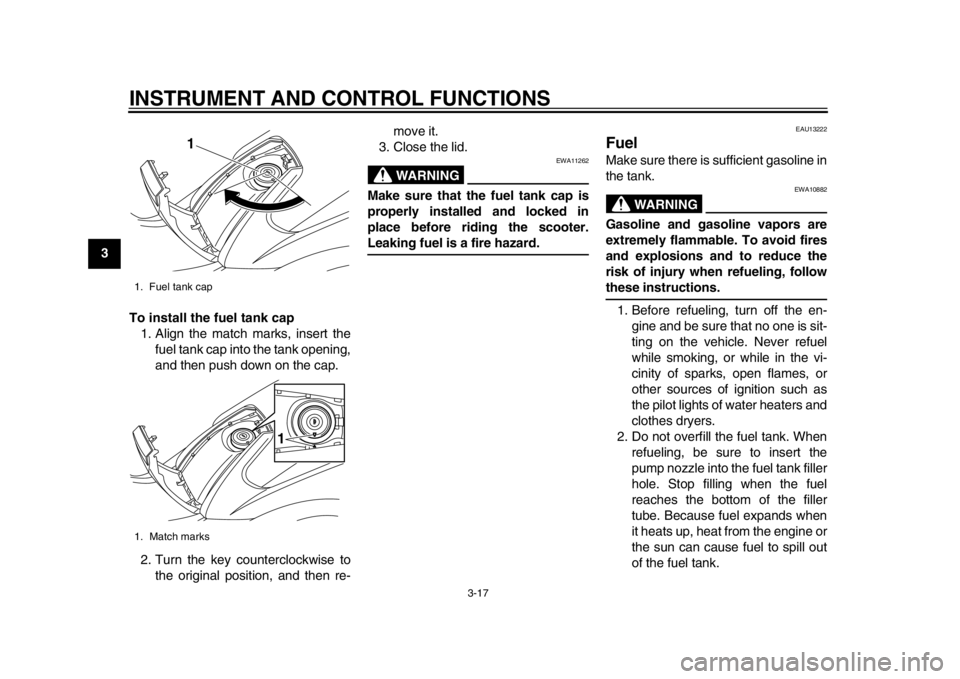light YAMAHA TMAX 2014 User Guide
[x] Cancel search | Manufacturer: YAMAHA, Model Year: 2014, Model line: TMAX, Model: YAMAHA TMAX 2014Pages: 100, PDF Size: 3.01 MB
Page 31 of 100

INSTRUMENT AND CONTROL FUNCTIONS
3-16
234
5
6
7
8
9
TIP
The ABS performs a self-diagno-
sis test each time the vehicle first
starts off after the key is turned to
“ON” and the vehicle has traveled
at a speed of 10 km/h (6 mi/h) or
higher. During this test, a “clicking”
noise can be heard from the front
of the vehicle, and if either brake
lever is even slightly applied, a vi-
bration can be felt at the lever, but
these do not indicate a malfunc-
tion.
This ABS has a test mode which
allows the owner to experience the
pulsation at the brake levers when
the ABS is operating. However,
special tools are required, so
please consult your Yamaha deal-er when performing this test.
NOTICE
ECA16121
Keep any type of magnets (including
magnetic pick-up tools, magnetic
screwdrivers, etc.) away from the
front and rear wheel hubs, otherwise
the magnetic rotors equipped in the
wheel hubs may be damaged, result- ing in improper performance of the
ABS system.
EAU13176
Fuel tank capTo remove the fuel tank cap
1. Open the lid by pulling the lever up.
2. Insert the key into the lock and turn it clockwise. The lock will be re-
leased and the fuel tank cap can
be removed.
1. Front wheel hub
1. Rear wheel hub
11
1. Opening lever
2. Lid
1
2
59C-9-E2.book 16 ページ 2013年6月18日 火曜日 午後1時33分
Page 32 of 100

INSTRUMENT AND CONTROL FUNCTIONS
3-17
1
23
4
5
6
7
8
9To install the fuel tank cap
1. Align the match marks, insert the fuel tank cap into the tank opening,
and then push down on the cap.
2. Turn the key counterclockwise to the original position, and then re- move it.
3. Close the lid.
WARNING
EWA11262
Make sure that the fuel tank cap is
properly installed and locked in
place before riding the scooter.Leaking fuel is a fire hazard.
EAU13222
FuelMake sure there is sufficient gasoline in
the tank.
WARNING
EWA10882
Gasoline and gasoline vapors are
extremely flammable. To avoid fires
and explosions and to reduce the
risk of injury when refueling, followthese instructions.
1. Before refueling, turn off the en- gine and be sure that no one is sit-
ting on the vehicle. Never refuel
while smoking, or while in the vi-
cinity of sparks, open flames, or
other sources of ignition such as
the pilot lights of water heaters and
clothes dryers.
2. Do not overfill the fuel tank. When refueling, be sure to insert the
pump nozzle into the fuel tank filler
hole. Stop filling when the fuel
reaches the bottom of the filler
tube. Because fuel expands when
it heats up, heat from the engine or
the sun can cause fuel to spill out
of the fuel tank.
1. Fuel tank cap
1. Match marks
1
1
59C-9-E2.book 17 ページ 2013年6月18日 火曜日 午後1時33分
Page 37 of 100

INSTRUMENT AND CONTROL FUNCTIONS
3-22
234
5
6
7
8
9
Front storage compartment B
To open the storage compartment
when it is locked, insert the key in the
lock, turn it clockwise, and then pull on
the lever while pushing the lever up. To open the storage compartment
when it is unlocked,
simply pull on the
lever while pushing the lever up.
To close the storage compartment,
push the lid into the original position.
To lock the storage compartment, push
the lid into the original position, insert
the key in the lock, turn it counterclock-
wise, and then remove it.
Rear storage compartment
A helmet can be stored in the rear stor-
age compartment under the seat. (See
page 3-19.) To store a helmet in the
rear storage compartment, place the
helmet upside down with the front fac-
ing the left side. NOTICE: Keep the
following points in mind when using
the storage compartment. Since the storage compartment accumulates
heat when exposed to the sun and/
or the engine heat, do not store any-
thing susceptible to heat, consum-
ables or flammable items inside it.
To avoid humidity from spreading
through the storage compartment,
wrap wet articles in a plastic bag be-
fore storing them in the compart-
ment. Since the storage
compartment may get wet while the
scooter is being washed, wrap any
articles stored in the compartment
in a plastic bag. Do not keep any-
thing valuable or breakable in the
storage compartment. Do not leave
the seat open for an extended period
of time, otherwise the light may
cause the battery to discharge.
[ECA16083]
NOTICE:
The shaded area is not a
storage compartment. To prevent
damaging the seat hinges, do not
place any items in this area.
[ECA16092]
1. Unlock.
2. Front storage compartment B
3. Storage compartment opening lever
1 2
3
59C-9-E2.book 22 ページ 2013年6月18日 火曜日 午後1時33分
Page 38 of 100

INSTRUMENT AND CONTROL FUNCTIONS
3-23
1
23
4
5
6
7
8
9
TIP
Some helmets cannot be stored in
the rear storage compartment be-
cause of their size or shape.
Do not leave your scooter unat-tended with the seat open.
NOTICE
ECA11101
Do not leave the rider seat open for
an extended period of time, other-
wise the light may cause the batteryto discharge.
WARNING
EWA16121
Do not exceed the following loadinglimits:
Front storage compartment A:
0.15 kg (0.3 lb)
Front storage compartment B: 1
kg (2 lb)
Rear storage compartment: 5 kg
(11 lb)
Maximum load for the vehicle:
XP500 198 kg (437 lb)XP500A 194 kg (428 lb)
EAU52212
WindshieldTo suit the rider’s preference, the wind-
shield height can be changed to one of
two positions.
To adjust the windshield height
1. Remove the screw access covers by removing the quick fasteners.
1. Rear storage compartment
2. Shaded area
1
2
1. Windshield
1
59C-9-E2.book 23 ページ 2013年6月18日 火曜日 午後1時33分
Page 41 of 100

INSTRUMENT AND CONTROL FUNCTIONS
3-26
234
5
6
7
8
9
EAU15306
SidestandThe sidestand is located on the left side
of the frame. Raise the sidestand or
lower it with your foot while holding the
vehicle upright.TIPThe built-in sidestand switch is part of
the ignition circuit cut-off system, which
cuts the ignition in certain situations.
(See the following section for an expla-
nation of the ignition circuit cut-off sys-tem.)
WARNING
EWA10242
The vehicle must not be ridden with
the sidestand down, or if the sides-
tand cannot be properly moved up
(or does not stay up), otherwise the
sidestand could contact the ground
and distract the operator, resulting
in a possible loss of control.
Yamaha’s ignition circuit cut-off
system has been designed to assist
the operator in fulfilling the respon-
sibility of raising the sidestand be-
fore starting off. Therefore, check
this system regularly and have aYamaha dealer repair it if it does not
function properly.
EAU45053
Ignition circuit cut-off systemThe ignition circuit cut-off system (com-
prising the sidestand switch and brake
light switches) has the following func-
tions.
It prevents starting when the side-
stand is up, but neither brake is ap-
plied.
It prevents starting when either
brake is applied, but the sidestand
is still down.
It cuts the running engine when the
sidestand is moved down.
Periodically check the operation of the
ignition circuit cut-off system according
to the following procedure.
59C-9-E2.book 26 ページ 2013年6月18日 火曜日 午後1時33分
Page 44 of 100

FOR YOUR SAFETY – PRE-OPERATION CHECKS
4-2
1
2
34
5
6
7
8
9
Rear brake Check operation.
If soft or spongy, have Yamaha dealer bleed hydraulic system.
Check brake pads for wear.
Replace if necessary.
Check fluid level in reservoir.
If necessary, add specified brake fluid to specified level.
Check hydraulic system for leakage. 6-20, 6-22, 6-23
Throttle grip Make sure that operation is smooth.
Check throttle grip free play.
If necessary, have Yamaha dealer adjust throttle grip free play and lubricate cable
and grip housing. 6-17, 6-25
Wheels and tires Check for damage.
Check tire condition and tread depth.
Check air pressure.
Correct if necessary. 6-17, 6-19
Brake levers Make sure that operation is smooth.
Lubricate lever pivoting points if necessary. 6-25
Centerstand, sidestand Make sure that operation is smooth.
Lubricate pivots if necessary. 6-26
Chassis fasteners Make sure that all nuts, bolts
and screws are properly tightened.
Tighten if necessary. —
Instruments, lights, signals
and switches Check operation.
Correct if necessary.
—
Sidestand switch Check operation of ignition circuit cut-off system.
If system is not working correctly, have Yamaha dealer check vehicle. 3-26
ITEM CHECKS PAGE
59C-9-E2.book 2 ページ 2013年6月18日 火曜日 午後1時33分
Page 45 of 100

5-1
2
3
456
7
8
9
OPERATION AND IMPORTANT RIDING POINTS
EAU15952
Read the Owner’s Manual carefully to
become familiar with all controls. If
there is a control or function you do not
understand, ask your Yamaha dealer.
WARNING
EWA10272
Failure to familiarize yourself with
the controls can lead to loss of con-
trol, which could cause an accidentor injury.
EAU48711
TIPThis model is equipped with:
a lean angle sensor to stop the en-
gine in case of a turnover. In this
case, the multi-function display in-
dicates error code 30, but this is
not a malfunction. Turn the key to
“OFF” and then to “ON” to clear the
error code. Failing to do so will pre-
vent the engine from starting even
though the engine will crank when
pushing the start switch.
an engine auto-stop system. The
engine stops automatically if left
idling for 20 minutes. If the engine
stops, simply push the start switchto restart the engine.
EAU54012
Starting the engineNOTICE
ECA10251
See page 5-4 for engine break-in in-
structions prior to operating the ve-hicle for the first time.
In order for the ignition circuit cut-off
system to enable starting, the sides-
tand must be up.
See page 3-26 for more information.
1. Turn the key to “ON” and make sure that the engine stop switch is
set to “ ”.
The following warning light, indica-
tor light and indicators should
come on for a few seconds, then
go off.
Engine trouble warning light
Immobilizer system indicator
light
V-belt replacement indicator
Oil change indicator
NOTICE
ECA17821
If the above warning light, indicator
light, or indicators do not come on
initially when the key is turned to
59C-9-E2.book 1 ページ 2013年6月18日 火曜日 午後1時33分
Page 46 of 100

OPERATION AND IMPORTANT RIDING POINTS
5-2
1
2
3
45
6
7
8
9“ON”, or if a warning light, indicator
light, or indicators remains on, see
pages 3-3, 3-5, 3-8, 3-9 or 3-11 for the
corresponding warning light, indica-
tor light or indicator circuit check.
For ABS models:
The ABS warning light should
come on when the main switch is
turned to “ON” and then go off af-
ter traveling at a speed of 10 km/h
(6 mi/h) or higher.
NOTICE
ECA17682
If the ABS warning light does not
come on and then go off as ex-
plained above, see page 3-3 for thewarning light circuit check.2. Close the throttle completely.
3. Start the engine by pushing the start switch while applying the front
or rear brake.
If the engine does not start, re-
lease the start switch, wait a few
seconds, and then try again. Each
starting attempt should be as short
as possible to preserve the bat-
tery. Do not crank the engine more
than 10 seconds on any one at- tempt.
NOTICE
ECA11043
For maximum engine life, never ac-
celerate hard when the engine iscold!
EAU45093
Starting off1. While pulling the rear brake lever
with your left hand and holding the
grab bar with your right hand, push
the scooter off the centerstand.
2. Sit astride the seat, and then ad- just the rear view mirrors.
3. Switch the turn signals on.
4. Check for oncoming traffic, and then slowly turn the throttle grip (on
the right) in order to take off.
5. Switch the turn signals off.1. Grab bar
1
59C-9-E2.book 2 ページ 2013年6月18日 火曜日 午後1時33分
Page 48 of 100

OPERATION AND IMPORTANT RIDING POINTS
5-4
1
2
3
45
6
7
8
9
EAU16821
Tips for reducing fuel
consumptionFuel consumption depends largely on
your riding style. Consider the following
tips to reduce fuel consumption:
Avoid high engine speeds during
acceleration.
Avoid high engine speeds with no
load on the engine.
Turn the engine off instead of let-
ting it idle for an extended length of
time (e.g., in traffic jams, at traffic
lights or at railroad crossings).
EAU16842
Engine break-inThere is never a more important period
in the life of your engine than the period
between 0 and 1600 km (1000 mi). For
this reason, you should read the follow-
ing material carefully.
Since the engine is brand new, do not
put an excessive load on it for the first
1600 km (1000 mi). The various parts in
the engine wear and polish themselves
to the correct operating clearances.
During this period, prolonged full-throt-
tle operation or any condition that might
result in engine overheating must be
avoided.
EAU36532
0–1000 km (0–600 mi)
Avoid prolonged operation above 4100
r/min. NOTICE: After 1000 km (600
mi) of operation, the engine oil must
be changed, and the oil filter car-
tridge or element replaced.
[ECA11283]
1000–1600 km (600–1000 mi)
Avoid prolonged operation above 5000
r/min. 1600 km (1000 mi) and beyond
The vehicle can now be operated nor-
mally.
NOTICE
ECA10311
Keep the engine speed out of
the tachometer red zone.
If any engine trouble should oc-
cur during the engine break-in
period, immediately have a
Yamaha dealer check the vehi-cle.
59C-9-E2.book 4 ページ 2013年6月18日 火曜日 午後1時33分
Page 55 of 100

PERIODIC MAINTENANCE AND ADJUSTMENT
6-6
2
3
4
567
8
9
24*Cooling system Check coolant level and vehicle
for coolant leakage.
Change coolant. Every 3 years
25 *V- b e l t Replace. When the V-belt replacement indicator flashes [every 20000 km (12500 mi)]
26 *Front and rear brake
switches Check operation.
27 Moving parts and
cables Lubricate.
28 *Throttle grip Check operation.
Check throttle grip free play, and
adjust if necessary.
Lubricate cable and grip housing.
29 *Lights, signals and
switches Check operation.
Adjust headlight beam.
NO. ITEM CHECK OR MAINTENANCE JOB
ODOMETER READING
ANNUAL
CHECK
1000 km
(600 mi) 10000 km
(6000 mi) 20000 km
(12000 mi) 30000 km
(18000 mi) 40000 km
(24000 mi)
59C-9-E2.book 6 ページ 2013年6月18日 火曜日 午後1時33分